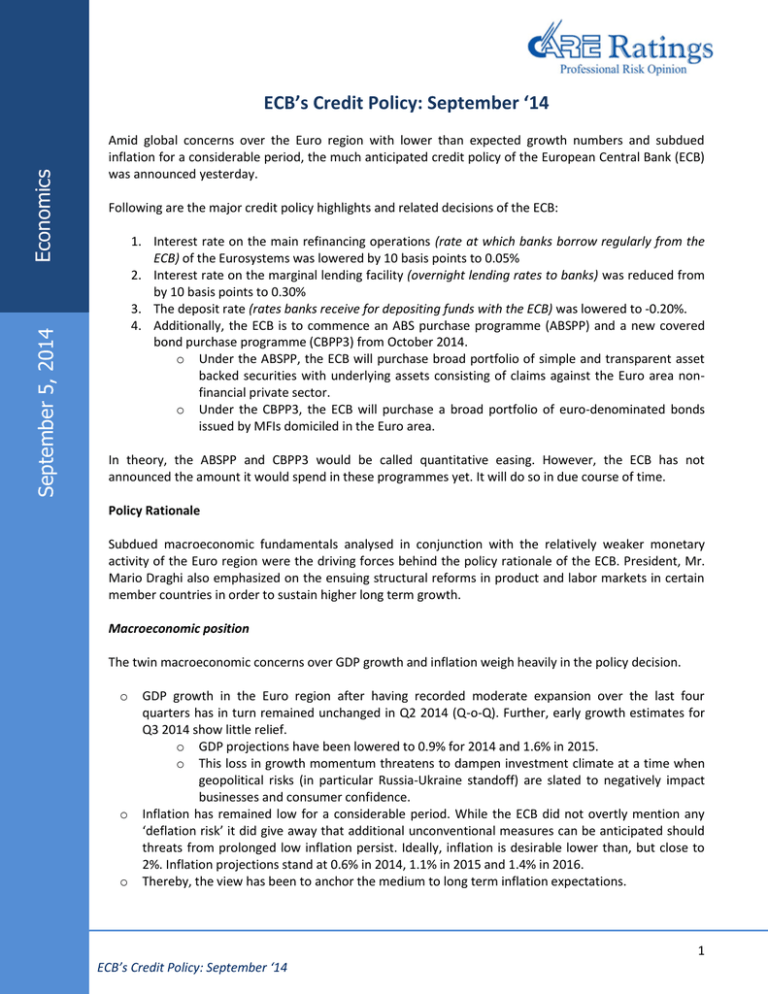ECB’s Credit Policy: September ‘14
advertisement

September 5, 2014 Economics ECB’s Credit Policy: September ‘14 Amid global concerns over the Euro region with lower than expected growth numbers and subdued inflation for a considerable period, the much anticipated credit policy of the European Central Bank (ECB) was announced yesterday. Following are the major credit policy highlights and related decisions of the ECB: 1. Interest rate on the main refinancing operations (rate at which banks borrow regularly from the ECB) of the Eurosystems was lowered by 10 basis points to 0.05% 2. Interest rate on the marginal lending facility (overnight lending rates to banks) was reduced from by 10 basis points to 0.30% 3. The deposit rate (rates banks receive for depositing funds with the ECB) was lowered to -0.20%. 4. Additionally, the ECB is to commence an ABS purchase programme (ABSPP) and a new covered bond purchase programme (CBPP3) from October 2014. o Under the ABSPP, the ECB will purchase broad portfolio of simple and transparent asset backed securities with underlying assets consisting of claims against the Euro area nonfinancial private sector. o Under the CBPP3, the ECB will purchase a broad portfolio of euro-denominated bonds issued by MFIs domiciled in the Euro area. In theory, the ABSPP and CBPP3 would be called quantitative easing. However, the ECB has not announced the amount it would spend in these programmes yet. It will do so in due course of time. Policy Rationale Subdued macroeconomic fundamentals analysed in conjunction with the relatively weaker monetary activity of the Euro region were the driving forces behind the policy rationale of the ECB. President, Mr. Mario Draghi also emphasized on the ensuing structural reforms in product and labor markets in certain member countries in order to sustain higher long term growth. Macroeconomic position The twin macroeconomic concerns over GDP growth and inflation weigh heavily in the policy decision. o o o GDP growth in the Euro region after having recorded moderate expansion over the last four quarters has in turn remained unchanged in Q2 2014 (Q-o-Q). Further, early growth estimates for Q3 2014 show little relief. o GDP projections have been lowered to 0.9% for 2014 and 1.6% in 2015. o This loss in growth momentum threatens to dampen investment climate at a time when geopolitical risks (in particular Russia-Ukraine standoff) are slated to negatively impact businesses and consumer confidence. Inflation has remained low for a considerable period. While the ECB did not overtly mention any ‘deflation risk’ it did give away that additional unconventional measures can be anticipated should threats from prolonged low inflation persist. Ideally, inflation is desirable lower than, but close to 2%. Inflation projections stand at 0.6% in 2014, 1.1% in 2015 and 1.4% in 2016. Thereby, the view has been to anchor the medium to long term inflation expectations. 1 ECB’s Credit Policy: September ‘14 Economics Monetary position o o Credit growth has been subdued and largely unchanged in the Euro region since 2013. Broad money supply growth (M3) has moderated in July ’14 relative to June’14. Further, growth rate of loans to households has been unchanged at 0.5% since early 2013. This reiterates the slowing Euro region economy. ECB expects introduction of the ABSPP and CBPP3 to enhance the functioning of the monetary policy transmission mechanism and provide support to the provision of credit to the broad economy. Fiscal Position o ECB President, Mr Draghi while being watchful reiterated the importance of maintaining fiscal prudence. Member states are in a position to bring about essential structural reforms in the product and labor markets in particular while being well on the fiscal consolidation path laid out in the ‘Stability and Growth Pact’1. The underlying thought is to lower the high public debt ratio over time in order to raise the growth potential thereby also increasing the conglomerate’s resilience to external shocks. Policy Impact o o o Firstly, keeping negative deposit rates was a step initiated in the previous credit policy. However, the action did not translate into any significant uptick in credit growth. Hence, it is unclear whether lowering the same further is likely to bear fruits this time around. Outright it appears as though the ECB is treading down a similar if not identical path laid down by the Federal Reserve Bank when it first implemented its quantitative easing programme, however, its impact may be limited as member countries are also required to maintain the fiscal consolidation path. Hence, credit growth may not be elevated to the extent as warranted by the Federal Reserve’s QE. There is a probability that investors would prefer to invest the surplus liquidity likely to be generated post the commencement of the ABSPP and CBPP3 in emerging market economies as opposed to the Euro region. In such an event, FII inflows into India among other EMEs will see an upswing. 1 Treaty among 28 member states of the EU to maintain economic stability in the Economic and Monetary Union (EMU).Members are requested to coordinate fiscal policies and avoid excessive deficit under the Pact. ECB’s Credit Policy: September ‘14 2 Economics Contact: Madan Sabnavis Chief Economist madan.sabnavis@careratings.com 91-022-67543489 Garima Mehta Associate Economist garima.mehta@careratings.com 91-022-61443526 Disclaimer This report is prepared by Credit Analysis &Research Limited. CARE Ratings has taken utmost care to ensure accuracy and objectivity while developing this report based on information available in public domain. However, neither the accuracy nor completeness of information contained in this report is guaranteed. CARE is not responsible for any errors or omissions in analysis/inferences/views or for results obtained from the use of information contained in this report and especially states that CARE Ratings (including all divisions) has no financial liability whatsoever to the user of this report. ECB’s Credit Policy: September ‘14 3